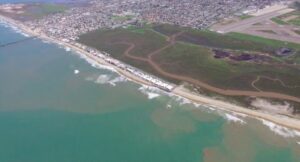September 23, 2020
 Representatives Juan Vargas, Susan Davis, Scott Peters, Mike Levin, and Raul Ruiz introduced the Border Water Quality Restoration and Protection Act of 2020, a House companion bill to Senator Dianne Feinstein’s legislation introduced in July. Both bills designate the U.S. Environmental Protection Agency as the lead agency to coordinate all federal, state, local, and Mexican agencies’ cross-boundary pollution mitigation efforts, helping improve the water quality of the Tijuana River and New River. Addressing transboundary pollution impacting the Tijuana River Valley in our region is one of our top priorities at the Chamber. The Chamber Board of Directors voted today to support the Senate and House bills.
Representatives Juan Vargas, Susan Davis, Scott Peters, Mike Levin, and Raul Ruiz introduced the Border Water Quality Restoration and Protection Act of 2020, a House companion bill to Senator Dianne Feinstein’s legislation introduced in July. Both bills designate the U.S. Environmental Protection Agency as the lead agency to coordinate all federal, state, local, and Mexican agencies’ cross-boundary pollution mitigation efforts, helping improve the water quality of the Tijuana River and New River. Addressing transboundary pollution impacting the Tijuana River Valley in our region is one of our top priorities at the Chamber. The Chamber Board of Directors voted today to support the Senate and House bills.
In addition, the U.S. Environmental Protection Agency announced two near-term projects to help mitigate water pollution impacting our region. The agency will enter into a Memorandum of Understanding with the International Boundary and Water Commission (IBWC) to divert additional water for treatment at the IBWC International Treatment Plant. The EPA is also partnering with the City of San Diego to rapidly develop and implement a permanent solution to better control sediment and trash at the border. This project will help reduce flooding risk for the community. Funding for projects will be provided by the EPA’s Border Water Infrastructure Program.
The Mexican section of the International Boundary and Water Commission (CILA, in Spanish) has allocated a bid to a local contractor for the administration and quality control of the rehabilitation of Pump Station CILA in the city of Tijuana. The project includes supervision and quality control of the acquisition and installation of pumps, pipes, and electric equipment, and the construction of pre-treatment grids and new water intake from the channel. In Baja, the Secretariat of Water Management, Sanitation, and Protection (SEPROA) reported that more than 289,000 cubic meters of sediment and solid waste have been removed from the Tijuana River channel. These upgrades are estimated to reduce the volume of northbound transboundary flows during the dry season by 70% and have already resulted in fewer transboundary flows reported in September.